Performance Evaluation of Downlink Multi-Beam Massive MIMO with Simple Transmission Scheme at Both Base and Terminal Stations
Abstract
:1. Introduction
2. Multi-Beam Massive MIMO Configuration Using CMA in the Uplink
2.1. Multi-Beam Massive MIMO Configuration Using CMA
2.2. Principle of CMA
3. Proposed Configuration and Beamforming Method Eliminating CSI in the Downlink
3.1. Configuration in Downlink and Beam Patterns Using Analog Weight
3.2. Residual Interference Elimination Method at the UTs
3.3. Effectiveness of Proposed Configuration and Method Through Computer Simulations
4. Modified Weight Update Method by LS-CMA and SD-CMA
4.1. Issue on LS-CMA Snd Switching Algorithm of CMA
4.2. Effectiveness of Proposed Method Verified through Computer Simulations
5. Conclusions
Acknowledgments
Author Contributions
Conflicts of Interest
References
- Gesbert, D.; Kountouris, M.; Heath, R.W., Jr.; Chae, C.-B.; Salzer, T. Shifting the MIMO Paradigm. IEEE Signal Process. Mag. 2007, 24, 36–46. [Google Scholar] [CrossRef]
- IEEE P802.11ac./D5.0, Part 11: Wireless LAN Medium Access Control (MAC and Physical Layer (PHY) specifications. Available online: http://ieeexplore.ieee.org/servlet/opac?punumber=6560343 (accessed on 20 November 2017).
- Hiraguri, T.; Nishimori, K. Survey of transmission methods and efficiency using MIMO technologies for wireless LAN systems. IEICE Trans. Commun. 2015, E98-B, 1250–1267. [Google Scholar] [CrossRef]
- Nishimori, K.; Hiraguri, T.; Makino, H. Transmission Rate by User Antenna Selection for Block Diagonalization Based Multiuser MIMO System. IEICE Trans. Commun. 2014, E97-B, 2118–2126. [Google Scholar] [CrossRef]
- Cisco Visual Networking Index: Global Mobile Data Traffic Forecast Update, 2010–2015. Available online: https://ja.scribd.com/document/49195955/Cisco-Global-Mobile-Data-Traffic-Forecast-Update-2010-2015-Feb-11 (accessed on 20 November 2017).
- Cisco Visual Networking Index: Global Mobile Data Traffic Forecast Update, 2016–2021. Available online: https://www.cisco.com/c/en/us/solutions/collateral/service-provider/visual-networking-index-vni/mobile-white-paper-c11-520862.html (accessed on 20 November 2017).
- Nakamura, T.; Nagata, S.; Benjebbour, A.; Kishiyama, Y.; Hai, T.; Xiaodong, S.; Ning, Y.; Nan, L. Trends in Small Cell Enhancements in LTE Advanced. IEEE Commun. Mag. 2013, 51, 98–105. [Google Scholar] [CrossRef]
- Kishiyama, Y.; Benjebbour, A.; Nakamura, T.; Ishii, H. Future Steps of LTE-A Evolution Toward Integration of Local Area and Wide Area Systems. IEEE Wirel. Commun. 2013, 20, 12–18. [Google Scholar]
- Larsson, E.G. Very Large MIMO systems. In Proceedings of the ICASSP 2012—IEEE International Conference on Acoustics, Speech and Signal Processing, Kyoto, Japan, 25–30 March 2012. [Google Scholar]
- Rusek, F.; Persson, D.; Lau, B.K.; Larsson, E.G.; Marzetta, T.L.; Edfors, O.; Tufvesson, F. Scaling Up MIMO: Opportunities and Challenges with Very Large Arrays. IEEE Signal Process. Mag. 2013, 30, 40–60. [Google Scholar] [CrossRef]
- Hoydis, J.; ten Brink, S.; Debbah, M. Massive MIMO in the UL/DL of Cellular Networks: How Many Antennas Do We Need? IEEE J. Sel. Areas Commun. 2013, 31, 160–171. [Google Scholar] [CrossRef] [Green Version]
- Papadopoulos, H.; Wang, C.; Bursalioglu, O.; Hou, X.; Kishiyama, Y. Massive MIMO Technologies and Challenges towards 5G. IEICE Trans. Commun. 2016, E99-B, 602–621. [Google Scholar] [CrossRef]
- Murakami, T.; Fukuzono, H.; Takatori, Y.; Mizoguchi, M. Multiuser MIMO with Implicit Channel Feedback in Massive Antenna Systems. IEICE Commun.Express 2013, 2, 336–342. [Google Scholar] [CrossRef]
- Nishimori, K.; Hiraguri, T.; Seki, T.; Yamada, H. Multi-beam Massive MIMO Using Analog Beamforming and DBF Based Blind Algorithm. In Proceedings of the 2015 International Symposium Antennas and Propagation (ISAP), Hobart, Australia, 9–12 November 2015. [Google Scholar]
- Hou, X.; Jiang, H.; Kayama, H.; Xi, W. A Novel Hybrid Beamforming Transmission Scheme for Common Channels and Signals. In Proceedings of the 2015 21st Asisa-Pacific Conference on Communications, Kyoto, Japan, 14–16 October 2015. [Google Scholar]
- Geng, J.; Wei, Z.; Wang, X.; Xiang, W.; Yang, D. Multiuser Hybrid Analog/Digital Beamforming for Relatively Large-scale Antenna Arrays. In Proceedings of the 2013 IEEE Globecom Workshops, Atlanta, GA, USA, 9–13 December 2013. [Google Scholar]
- Treichler, J.R.; Agee, B.G. A New Approach to Multipath Correction of Constant Modulus Signals. IEEE Trans. Acoust. Speech Signal Process. 1983, 31, 459–472. [Google Scholar] [CrossRef]
- Taniguchi, R.; Nishimori, K.; Makino, H. Multi-beam Massive MIMO using Constant Modulus Algorithm for QAM Signal employing Amplitude and Phase Offset Compensation. IEICE Trans. Commun. 2017, E100-B, 262–268. [Google Scholar] [CrossRef]
- Butler, J.; Lowe, R. Beamforming Matrix Simplifies Design of Electronically Scanned Antennas. Electron. Des. 1961, 9, 170–173. [Google Scholar]
- Zeng, Y.; Zhang, R.; Chen, Z.N. Electromagnetic Lens-Focusing Antenna Enabled Massive MIMO. In Proceedings of the IEEE/CIC International Conference Communication in China (ICCC), Xi’an, China, 12–14 August 2013; pp. 454–459. [Google Scholar]
- Heath, R.W., Jr.; Gonzalez-Prelcic, N.; Rangan, S.; Roh, W.; Sayeed, A. An Overview of Signal Processing Techniques for Millimeter Wave MIMO Systems. IEEE J.Sel. Top. Signal Process. 2016, 10, 436–453. [Google Scholar] [CrossRef]
- Yamamoto, S.-I.; Hirokawa, J.; Ando, M. A Single-Layer Hollow-Waveguide 8-Way Butler Matrix with Modified Phase Shifters. In Proceedings of the ISAP2005, Seoul, Korea, 3–5 August 2005. [Google Scholar]
- Tanaka, T.; Miura, R.; Chiba, I.; Karasawa, Y. An ASIC Implementation Scheme to Realize a BeamSpace CMA Adaptive Array Antenna. IEICE Trans. Commun. 1995, E78-B, 1467–1473. [Google Scholar]
- Agee, B.G. The Least-Square CMA: A New Technique for Rapid Correction of Constant Modulus Signals. In Proceedings of the IEEE International Conference on ICASSP ’86 Acoustics, Speech, and Signal Processing, Tokyo, Japan, 7–11 April 1986; pp. 953–956. [Google Scholar]
- Nishimori, K.; Yomo, H.; Popovski, P. Distributed Interference Cancellation for Cognitive Radios using Periodic Signals of the Primary System. IEEE Trans. Wirel. Commun. 2011, 10, 2791–2981. [Google Scholar]
- Kikuma, K.; Takai, K.; Nishimori, K.; Saito, F.; Inagaki, N. Consideration on Performance of the CMA Adaptive Array Antenna for 16QAM Signals. In Proceedings of the Personal, Indoor and Mobile Radio Communications (PIMRC) 1995, Toronto, ON, Canada, 27–29 September 1995; Volume 2, pp. 677–681. [Google Scholar]
- Nishimori, K.; Kikuma, K.; Inagaki, N. Performance analysis of CMA adaptive array for QAM signals. Electron. Commun. Jpn. (Part 1 Commun.) 1997, 80, 11–21. [Google Scholar] [CrossRef]


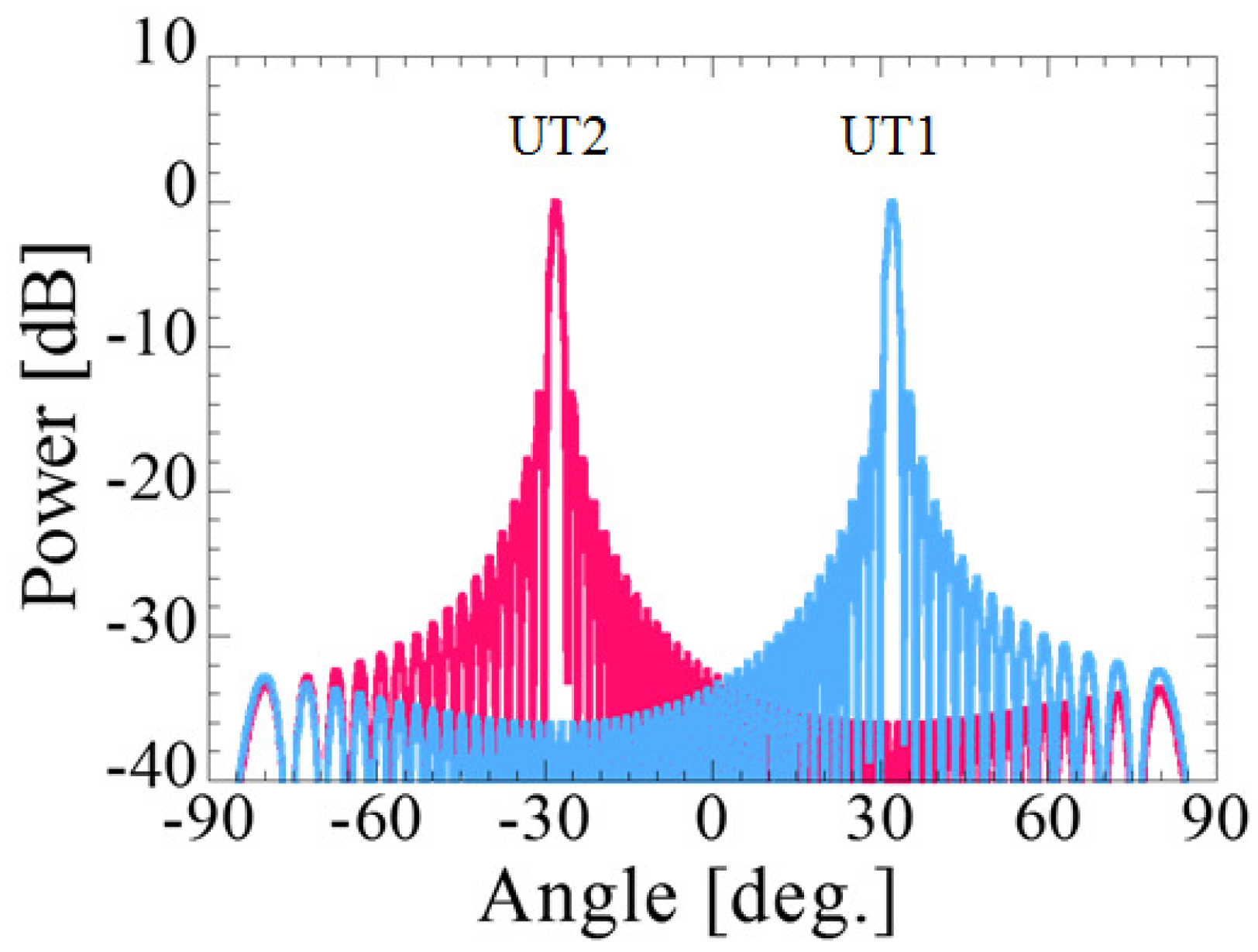
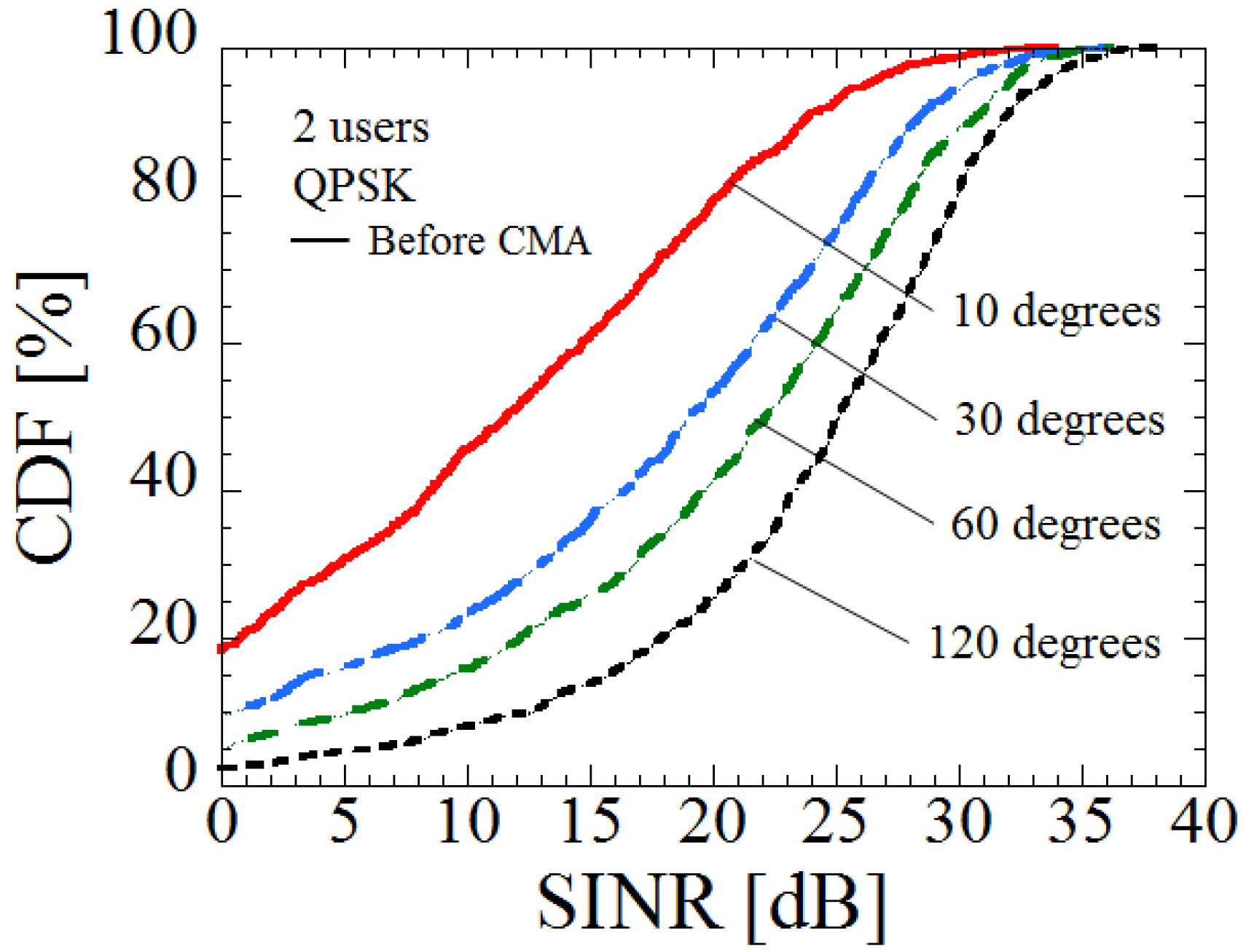
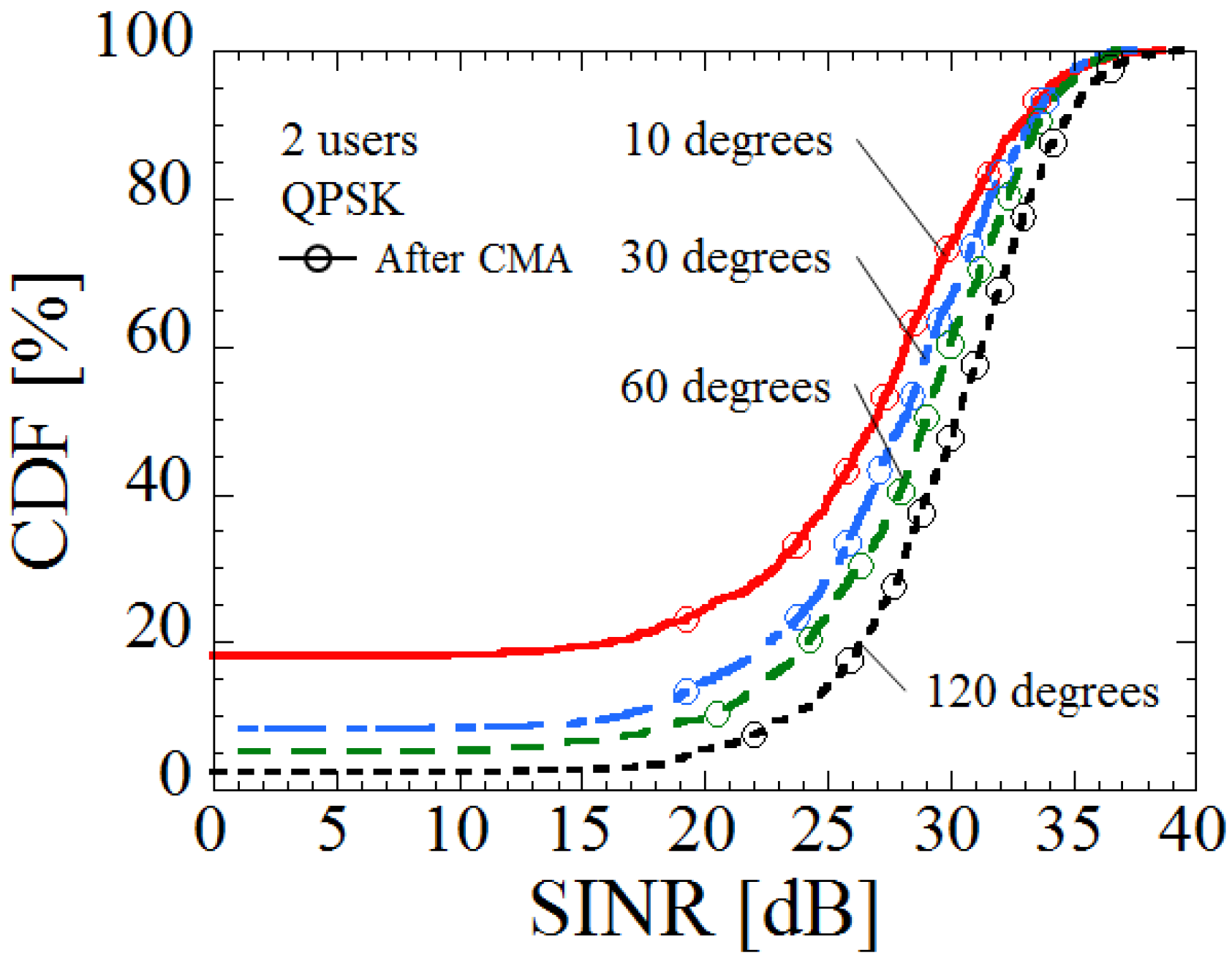


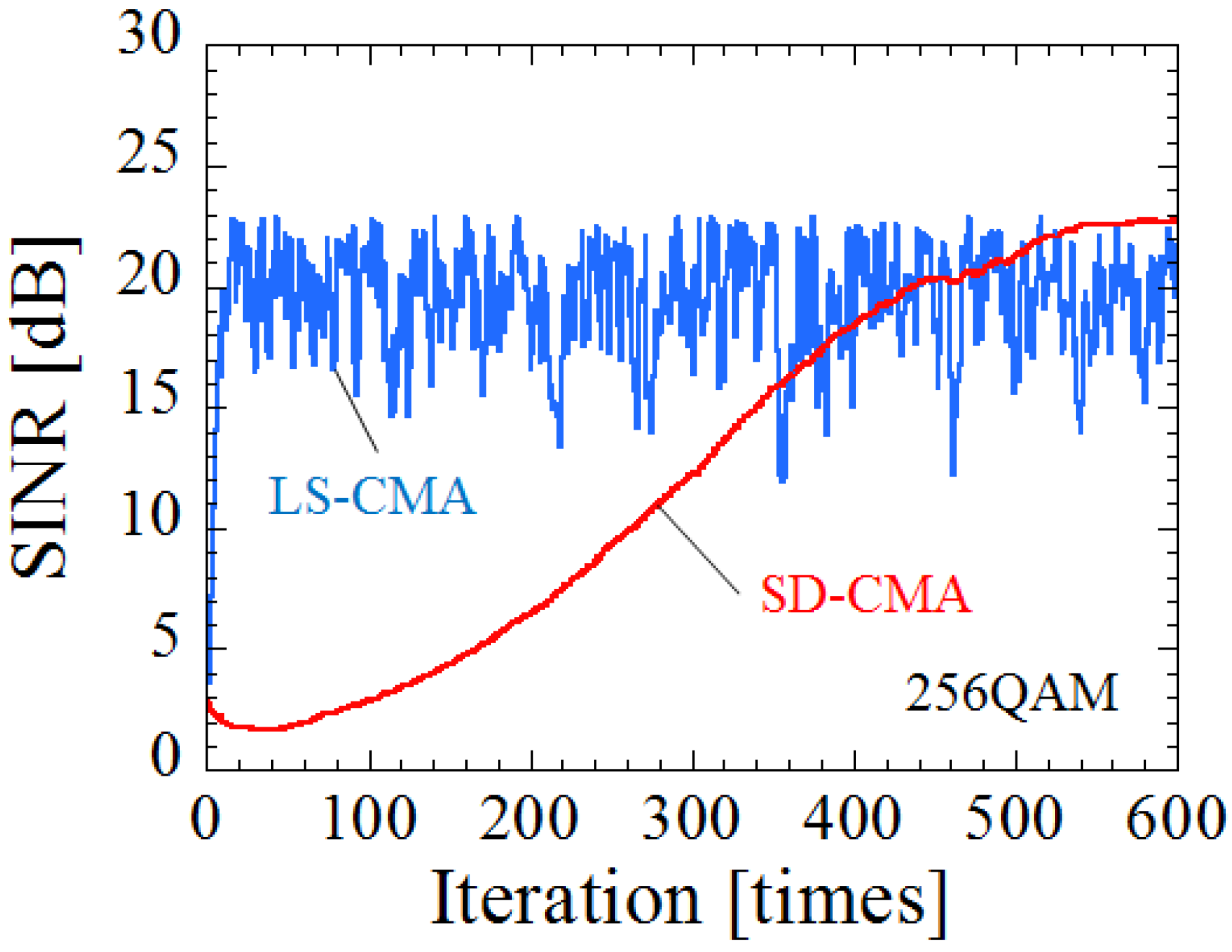
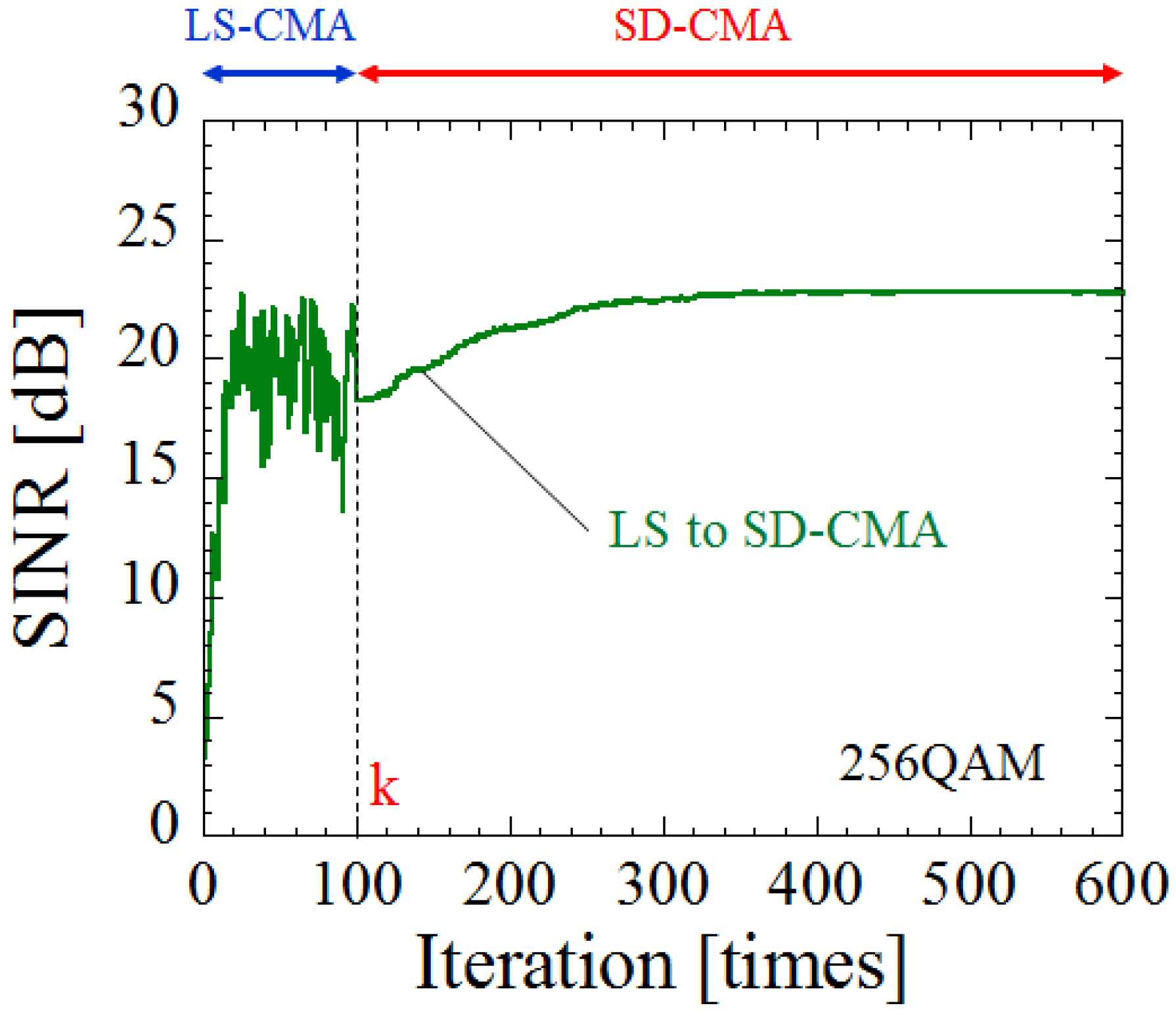
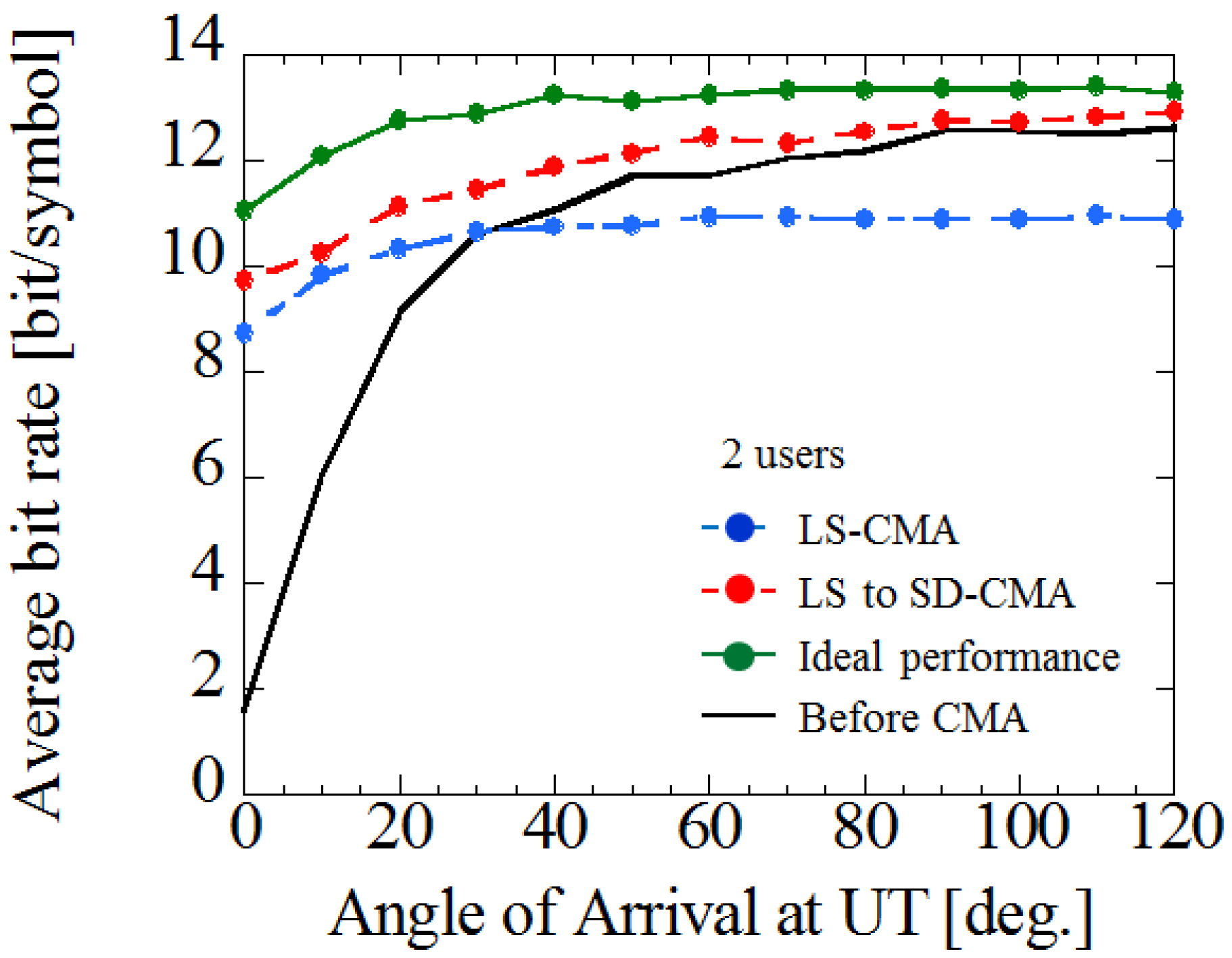
| Parameter | Value |
|---|---|
| Number of Transmission antennas | 64 |
| Number of receive user terminals (UTs) | 2 |
| Angular difference between receive UTs | 0∼120 degrees |
| Number of receive antennas at each UT | 2 |
| Number of beams | 1∼3 |
| Symbol length | 10000 symbols |
| Least-square constant modulus algorithm (LS-CMA) smoothing size | 500 symbols |
| Number of pilot signals | 5 symbols |
| Number of trials | 1000 times |
| Average signal to noise power ratio (SNR) | 30 dB |
| Smoothing Size | Iteration | |
|---|---|---|
| LS-CMA | 50 | 20 |
| least-square to steepest-descent-CMA (LS-to-SD-CMA) | 50 | 20 |
| Ideal performance | 500 | 20 |
© 2017 by the authors. Licensee MDPI, Basel, Switzerland. This article is an open access article distributed under the terms and conditions of the Creative Commons Attribution (CC BY) license (http://creativecommons.org/licenses/by/4.0/).
Share and Cite
Ogawa, S.; Nishimori, K.; Taniguchi, R.; Mitsui, T.; Hiraguri, T. Performance Evaluation of Downlink Multi-Beam Massive MIMO with Simple Transmission Scheme at Both Base and Terminal Stations. Electronics 2017, 6, 100. https://doi.org/10.3390/electronics6040100
Ogawa S, Nishimori K, Taniguchi R, Mitsui T, Hiraguri T. Performance Evaluation of Downlink Multi-Beam Massive MIMO with Simple Transmission Scheme at Both Base and Terminal Stations. Electronics. 2017; 6(4):100. https://doi.org/10.3390/electronics6040100
Chicago/Turabian StyleOgawa, Shota, Kentaro Nishimori, Ryotaro Taniguchi, Tsutomu Mitsui, and Takefumi Hiraguri. 2017. "Performance Evaluation of Downlink Multi-Beam Massive MIMO with Simple Transmission Scheme at Both Base and Terminal Stations" Electronics 6, no. 4: 100. https://doi.org/10.3390/electronics6040100





